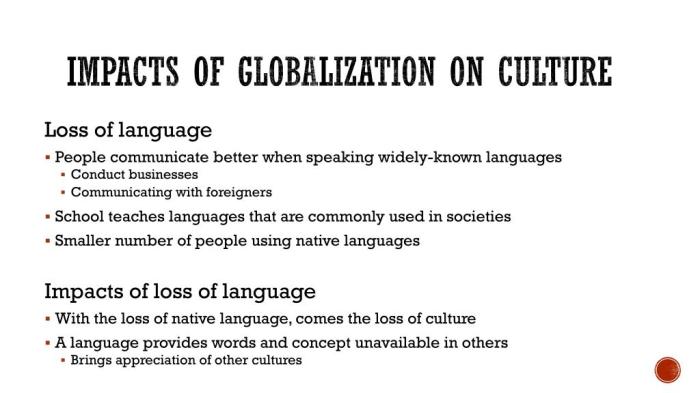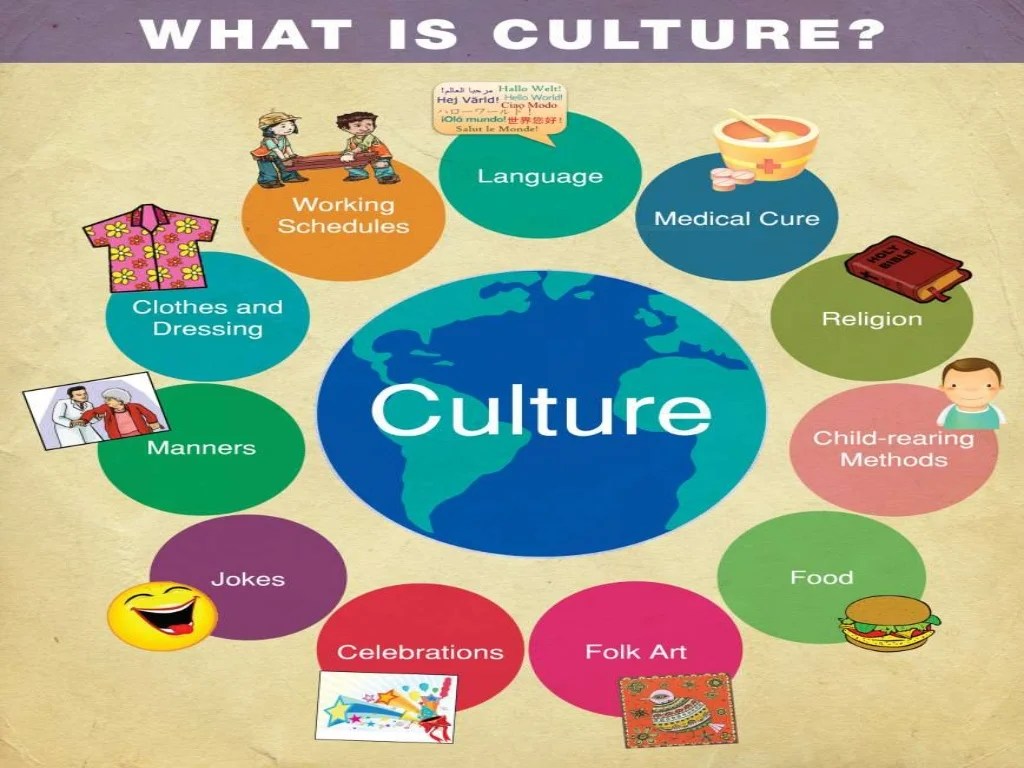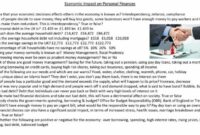The impact of globalization on modern cultural identities – Globalization’s impact on modern cultural identities is a multifaceted phenomenon, weaving a complex tapestry of cultural preservation, hybridity, and exchange. It’s a story of both homogenization and diversification, where traditional practices face unprecedented challenges while new cultural forms emerge from the melting pot of global interaction. This exploration delves into the ways globalization reshapes our understanding of identity, examining the roles of technology, media, and power dynamics in this ever-evolving landscape.
From the spread of global brands and media to the rise of hybrid cultural expressions, globalization profoundly alters how we define and experience culture. This examination will analyze the tensions between global and local influences, exploring both the threats and opportunities presented by this increasingly interconnected world. We’ll investigate how communities strive to preserve their heritage amidst global pressures, and how new identities are forged in the crucible of cultural exchange.
Globalization’s Influence on Cultural Preservation
Globalization presents a complex and multifaceted challenge to the preservation of cultural identities. While it fosters interconnectedness and exchange, it also risks homogenization, threatening the unique traditions and practices that define diverse communities. The rapid spread of globalized media, consumerism, and migration patterns can overwhelm local customs, leading to the erosion of traditional knowledge, languages, and artistic expressions. Understanding these challenges is crucial for developing effective strategies to safeguard cultural heritage for future generations.Globalization significantly impacts the transmission of cultural heritage.
Traditional methods of passing down knowledge, skills, and beliefs – often through oral storytelling, apprenticeship, and ritualistic practices – face competition from globalized media and educational systems. Younger generations, exposed to a wider range of cultural influences, may find it challenging to connect with and value their own cultural heritage, leading to a decline in participation in traditional activities and a weakening of cultural identity.
This generational shift can result in the loss of invaluable cultural practices and knowledge.
Challenges to Cultural Preservation Posed by Globalization
The homogenizing effects of globalization pose a significant threat to cultural diversity. The dominance of global brands, media, and entertainment often overshadows local cultural expressions, leading to a decline in the use of local languages, traditional crafts, and indigenous knowledge systems. For example, the popularity of fast food chains can displace local culinary traditions, while the prevalence of global pop music may diminish interest in indigenous musical forms.
This cultural dilution can lead to a loss of unique cultural identities and the erosion of community cohesion. Furthermore, economic pressures associated with globalization, such as the shift towards industrial agriculture, can disrupt traditional livelihoods and practices that are integral to maintaining cultural heritage.
Impact of Globalization on Intergenerational Transmission of Cultural Heritage
Globalization’s influence on the transmission of cultural heritage across generations is profound. The increased accessibility of global media and the internet exposes younger generations to a vast array of cultural influences, potentially diluting the importance of their own cultural heritage. Traditional methods of cultural transmission, such as storytelling and apprenticeship, may become less relevant as younger generations gravitate towards digital forms of entertainment and communication.
This can lead to a knowledge gap between generations, resulting in the loss of traditional skills, languages, and cultural practices. The shift towards urban lifestyles also contributes to this phenomenon, as traditional rural communities, often the custodians of cultural heritage, experience depopulation and a decline in the practice of traditional ways of life.
Globalization’s impact on modern cultural identities is complex, blurring lines and creating hybrid cultures. Finding meaning in this shifting landscape often involves re-evaluating what constitutes a “good life,” which is where the concept of Achieving a fulfilling luxury lifestyle beyond material possessions becomes relevant. Ultimately, a fulfilling life transcends material wealth and necessitates a conscious engagement with one’s evolving cultural identity in a globalized world.
Successful Strategies for Safeguarding Cultural Identities
Many communities are actively employing innovative strategies to protect their cultural identities in the face of globalization. These include revitalizing traditional arts and crafts through educational programs and community initiatives; promoting the use of local languages through language immersion programs and media production; documenting and archiving traditional knowledge systems; and leveraging tourism to generate economic opportunities while preserving cultural authenticity.
For example, indigenous communities are using social media platforms to share their stories, languages, and cultural practices with a wider audience, effectively countering the homogenizing effects of globalization. Moreover, the establishment of cultural centers and museums dedicated to preserving and promoting local heritage plays a vital role in fostering cultural pride and awareness among younger generations.
Technology’s Dual Role in Preserving and Threatening Cultural Heritage, The impact of globalization on modern cultural identities
Technology plays a double-edged role in the context of globalization and cultural preservation. While the internet and digital platforms can facilitate the dissemination of cultural information and connect communities across geographical boundaries, they can also contribute to cultural homogenization and the erosion of local traditions. The dominance of global social media platforms, for example, can lead to the displacement of local communication channels and cultural expressions.
Conversely, digital technologies offer powerful tools for documenting and preserving cultural heritage. High-resolution imaging, 3D scanning, and digital archiving techniques enable the creation of detailed records of traditional art forms, archaeological sites, and oral histories. Online platforms can also be used to share and promote cultural heritage materials, reaching wider audiences and fostering intercultural understanding. The key lies in utilizing technology strategically to empower communities to control the narrative surrounding their cultural heritage and to leverage digital platforms to preserve and promote their unique identities.
Cultural Hybridity and the Creation of New Identities
Globalization’s interconnected world has led to an unprecedented mixing of cultures, resulting in the emergence of hybrid cultural identities. This blending isn’t simply a superficial adoption of elements from different cultures; it’s a complex process of negotiation, adaptation, and creation, leading to unique and dynamic expressions of identity. These new identities often challenge traditional notions of cultural purity and offer fascinating insights into the fluidity and adaptability of human culture.Globalization facilitates the interaction and fusion of cultural elements through increased migration, communication technologies, and global media.
This exposure leads individuals and communities to selectively adopt and adapt elements from different cultures, creating new forms of expression that reflect their unique experiences and circumstances. This process is not always harmonious; it can also lead to tensions and conflicts as different cultural values and practices clash.
Examples of Hybrid Cultural Identities
The creation of hybrid cultural identities is evident across the globe. Consider, for example, the emergence of “Spanglish” in the United States, a blend of Spanish and English that reflects the linguistic realities of many Hispanic communities. This isn’t simply code-switching; it involves the creation of new grammatical structures and vocabulary, demonstrating a unique cultural expression. Similarly, in many urban centers around the world, musical genres constantly evolve through the fusion of different traditions.
Globalization’s impact on modern cultural identities is complex, often blurring lines between traditions. Finding genuine cultural experiences becomes crucial, and this is where understanding luxury’s true meaning comes in. To navigate this, check out this helpful guide on How to find authentic luxury experiences instead of superficial ones , which can help you distinguish between staged and genuine cultural immersion.
Ultimately, discerning authentic experiences helps us appreciate the nuances of global cultural identities better.
World music, for example, blends elements of various musical styles, creating soundscapes that are both familiar and novel. In the culinary world, fusion cuisine—like Tex-Mex or Indo-Chinese— showcases the creative blending of culinary traditions.
Comparative Experiences of Cultural Blending
Different communities experience globalization-induced cultural blending in diverse ways, shaped by factors such as pre-existing cultural structures, power dynamics, and the nature of the interaction. Immigrant communities, for example, often experience a complex interplay between maintaining their heritage and adapting to the dominant culture, leading to unique forms of cultural negotiation and hybridity. Indigenous communities, on the other hand, may face the pressure of cultural assimilation or even erasure in the face of globalization, leading to struggles for cultural preservation and the assertion of their identities.
The experiences of these groups highlight the uneven power dynamics inherent in globalization’s impact on culture.
Globalization’s impact on modern cultural identities is a complex issue, with the blending of traditions often leading to fascinating new expressions. However, this exposure also creates pressure to adopt certain lifestyles, often fueled by aspirational marketing. Learning to manage this pressure requires a thoughtful approach to personal finances, something explored in detail at this helpful guide on Balancing luxury lifestyle with financial responsibility.
Ultimately, navigating this carefully allows individuals to preserve unique cultural elements while making informed choices about their spending habits.
Globalization’s Role in Fostering New Cultural Forms
Globalization acts as a catalyst for the creation of new cultural forms and expressions by facilitating the exchange of ideas, technologies, and artistic styles across geographical boundaries. The internet, for instance, has played a significant role in disseminating cultural products and facilitating the creation of online communities that transcend geographical limitations. This allows for cross-cultural collaboration and the emergence of new artistic styles and expressions that draw inspiration from multiple sources.
The rise of globalized social movements also showcases the ability of globalization to foster the creation of new forms of collective identity and action.
Hypothetical Scenario: The Formation of a New Cultural Identity
Imagine a coastal community where a group of indigenous fishermen, known for their traditional boat-building techniques and sea shanties, interacts with a group of immigrant artists specializing in vibrant street art and hip-hop music. Over time, the fishermen begin incorporating elements of street art into their boat designs, creating vibrant, eye-catching vessels. Simultaneously, the immigrant artists incorporate elements of sea shanties into their hip-hop music, resulting in a unique fusion of traditional and contemporary styles.
This interaction creates a new cultural identity that blends the traditional skills and aesthetics of the indigenous community with the modern artistic expressions of the immigrants. This new identity isn’t simply a sum of its parts; it represents a unique synthesis, a testament to the creative potential of cultural exchange.
The Impact of Globalization on Cultural Diffusion and Exchange
Globalization has profoundly reshaped the way cultures interact, leading to an unprecedented level of cultural diffusion and exchange. This interconnectedness, driven by advancements in technology, communication, and transportation, has facilitated the movement of ideas, practices, and artifacts across geographical boundaries at an unparalleled speed and scale. However, this process is not uniform; power dynamics significantly influence the direction and impact of cultural flows.
Globalization facilitates cultural diffusion primarily through several interconnected mechanisms. The rapid spread of information and communication technologies, such as the internet and social media, allows cultural elements to be instantly disseminated globally. International trade and tourism expose people to diverse cultures, fostering cross-cultural interaction and the adoption of foreign customs and practices. Migration, both voluntary and forced, leads to the transplanting of cultural traditions and the creation of hybrid cultural forms in new locations.
Finally, the influence of global media corporations and transnational organizations contributes significantly to the dissemination of specific cultural values and products.
Examples of Globally Spread Cultural Elements and Their Transformations
Numerous cultural elements have experienced widespread diffusion due to globalization. For example, K-pop, originating in South Korea, has achieved immense global popularity, captivating audiences worldwide with its unique blend of music, dance, and fashion. However, its global reception has involved adaptation; K-pop artists often incorporate elements of Western pop music into their work to broaden their appeal.
Globalization’s impact on cultural identities is a complex issue, often blurring lines between traditions. For instance, the rise of unique travel experiences reflects this shift; check out these amazing Luxury lifestyle travel experiences for solo travelers to see how individual exploration intersects with global trends. Ultimately, the ease of global travel and cultural exchange both strengthens and challenges how we understand and define our own cultural identities.
Similarly, Bollywood films, produced in India, have gained a significant international following, demonstrating the capacity of a specific national cinema to transcend geographical boundaries. However, the films often undergo localization processes to resonate better with different audiences, involving dubbing or subtitles and sometimes minor plot adjustments.
Another example is the global spread of fast food chains. McDonald’s, for instance, has adapted its menus to suit local tastes and preferences in various countries, incorporating regionally specific ingredients and flavors. This demonstrates a process of cultural hybridization, where global brands adapt to local contexts while simultaneously disseminating their own cultural elements.
Uneven Distribution of Cultural Influence and Power Dynamics
The global distribution of cultural influence is far from even. Powerful nations and corporations often exert disproportionate influence, shaping global cultural trends and disseminating their values and products on a massive scale. This dominance reflects existing power imbalances in the global system. Hollywood films, for example, dominate the global film industry, often overshadowing productions from less powerful nations.
Similarly, Western fashion trends frequently set the tone for global fashion, although local styles and traditions continue to assert themselves and sometimes influence the dominant trends.
This uneven distribution is not merely a matter of market share; it involves the dissemination of ideologies and values. The dominance of certain languages, particularly English, in global communication reinforces existing power structures and can marginalize less dominant languages and cultures. This unequal flow of cultural influence can lead to the homogenization of cultures and the erosion of cultural diversity.
Comparative Analysis of Cultural Element Diffusion
The speed and extent of cultural diffusion vary significantly depending on the cultural element in question and the mechanisms facilitating its spread. The following table offers a comparative analysis:
| Cultural Element | Speed of Diffusion | Extent of Diffusion | Primary Mechanisms |
|---|---|---|---|
| Music (e.g., Pop, K-Pop) | Rapid (viral spread through online platforms) | Global (extensive reach via streaming services and social media) | Internet, social media, streaming platforms |
| Fashion | Moderate to Rapid (influenced by trends showcased in global fashion weeks and social media) | Global (though with regional variations and adaptations) | Social media, fashion magazines, international brands |
| Cuisine | Moderate (spread through migration, tourism, and international restaurants) | Regional to Global (varies depending on the dish and its adaptability) | Migration, tourism, international restaurants, cookbooks |
| Film | Moderate to Rapid (dependent on distribution networks and marketing) | Global (with regional variations in popularity) | Streaming platforms, cinemas, international film festivals |
Globalization and the Rise of Global Culture

Source: slideserve.com
Globalization has fostered the emergence of a global culture, a complex phenomenon characterized by the increasing interconnectedness and shared experiences across national borders. This shared culture isn’t a monolithic entity replacing local traditions, but rather a layer interwoven with existing cultural fabrics, sometimes harmoniously, sometimes conflictually. It’s driven by the rapid exchange of information, ideas, and cultural products facilitated by technology and interconnected economies.The defining characteristics of global culture include the widespread dissemination of similar trends in fashion, music, food, and media consumption.
It’s marked by the rise of transnational corporations and brands, which shape consumer preferences and lifestyles globally. The adoption of similar communication technologies and the spread of English as a lingua franca further solidify this interconnectedness. However, it’s crucial to remember that this shared culture exists alongside, and often interacts with, vibrant local cultures.
Global Cultural Products and Their Impact
The proliferation of global cultural products significantly influences local cultures. Hollywood films, for example, dominate global box offices, shaping narratives and aesthetic preferences worldwide. While some argue this leads to cultural homogenization, others emphasize the adaptation and reinterpretation of these products within local contexts. Similarly, global music genres like K-pop or reggaeton achieve widespread popularity, often incorporating local elements to resonate with diverse audiences.
The influence of global brands like Coca-Cola or Nike is evident in their ubiquitous presence and their successful integration into local consumption patterns. These brands often adapt their marketing strategies to resonate with local sensibilities, yet simultaneously contribute to a sense of globalized consumerism.
Globalization, Homogenization, and Diversification
Globalization’s impact on culture is a double-edged sword. On one hand, it contributes to cultural homogenization, a process where distinct cultural traits become increasingly similar due to the dominance of global trends and products. The spread of Western cultural values and consumption patterns, for instance, is often cited as an example. However, globalization also fuels cultural diversification. The increased interaction between different cultures leads to hybridity, where new cultural forms emerge from the blending of existing ones.
The fusion cuisine found in many global cities, combining elements from various culinary traditions, exemplifies this phenomenon. Furthermore, globalization provides platforms for marginalized or underrepresented cultures to gain visibility and share their stories with a global audience.
A Visual Representation of Global and Local Culture Interplay
Imagine a vibrant tapestry. The warp threads represent the diverse local cultures – intricate designs, varied colors, and unique textures reflecting the rich tapestry of human experience. The weft threads, running across the warp, represent the global culture – threads of similar color (e.g., the prevalence of certain technologies or brands) interwoven with the warp threads. In some areas, the global threads are more prominent, influencing the overall pattern.
In others, the local threads maintain their strong individuality, even as they interact with the global threads. The resulting pattern is neither uniformly homogenous nor completely fragmented; it’s a dynamic, ever-evolving blend of global and local influences, where both are constantly shaping and reshaping each other. The tapestry is constantly changing as new threads are added and old ones fade, illustrating the ongoing process of cultural interaction and transformation within the context of globalization.
The Role of Media and Technology in Shaping Cultural Identities
Globalization, fueled by advancements in media and technology, has profoundly reshaped how we perceive and construct cultural identities. The constant flow of information and images across borders blurs traditional boundaries, creating a complex interplay between global and local influences. This pervasive influence affects not only how we see ourselves but also how we interact with others, fostering both cultural exchange and conflict.Global media’s influence on the perception and construction of cultural identities is undeniable.
Television programs, films, and music, often originating from dominant cultural centers, set trends and shape perceptions of what is considered desirable, fashionable, or even “normal.” This can lead to the adoption of foreign cultural elements, a process sometimes referred to as cultural appropriation, or the internalization of specific values and ideals that may not align with pre-existing cultural norms.
Conversely, it can also stimulate a renewed interest in local traditions and a push for cultural preservation in response to perceived threats of homogenization.
Global Media’s Impact on Cultural Perception
The portrayal of cultures in global media is often selective and biased, reflecting the perspectives and priorities of the producers. For example, representations of developing nations in Western media may focus on poverty or conflict, neglecting the richness and diversity of their cultures. Similarly, the portrayal of minority cultures within a dominant culture can perpetuate stereotypes and reinforce existing power imbalances.
This selective representation significantly shapes global perceptions and can lead to misinterpretations and misunderstandings between different cultural groups. The lack of diversity in media production also contributes to this issue, with underrepresentation of creators from diverse backgrounds leading to a limited range of perspectives being showcased.
Social Media’s Role in Disseminating and Resisting Cultural Norms
Social media platforms have become powerful tools for both the dissemination and resistance of cultural norms. On one hand, they facilitate the rapid spread of global trends and ideas, connecting people across geographical boundaries and fostering a sense of shared identity. On the other hand, they also provide spaces for marginalized groups to challenge dominant narratives and assert their own cultural identities.
For instance, social media campaigns have been instrumental in raising awareness about cultural appropriation and promoting the recognition and celebration of diverse cultural expressions. However, the spread of misinformation and hate speech on these platforms also poses a significant challenge, potentially exacerbating cultural conflicts and undermining efforts at cultural understanding.
Technological Advancements and the Preservation and Transformation of Languages
Technological advancements have had a significant impact on the preservation and transformation of languages and dialects. While the internet and digital technologies offer unprecedented opportunities for language learning and cultural exchange, they also pose threats to linguistic diversity. The dominance of certain languages online, particularly English, can lead to the marginalization of less widely spoken languages, potentially contributing to their decline or even extinction.
However, digital technologies also offer tools for language preservation, such as online dictionaries, language learning apps, and digital archives of oral traditions. These tools can help to revitalize endangered languages and ensure their continued use in the digital age. For example, initiatives using online platforms to document and teach indigenous languages are showing promising results in preserving linguistic heritage.
Comparative Impact of Different Media Platforms on Cultural Identities
Television, film, and the internet each shape cultural identities in distinct ways. Television, with its broad reach and often standardized programming, can contribute to the homogenization of cultural values and tastes. Film, with its capacity for storytelling and artistic expression, can offer more nuanced and diverse portrayals of cultures, challenging stereotypes and promoting intercultural understanding. The internet, with its decentralized and participatory nature, allows for a greater diversity of voices and perspectives, fostering both the creation of new cultural identities and the preservation of existing ones.
The internet’s ability to connect individuals with similar cultural backgrounds, regardless of geographical location, creates virtual communities that reinforce and strengthen cultural identities. This contrasts sharply with the more centralized and often homogenizing influence of traditional broadcast media.
Closure: The Impact Of Globalization On Modern Cultural Identities

Source: slidesharecdn.com
In conclusion, the impact of globalization on modern cultural identities is a dynamic and ongoing process. While globalization undeniably presents challenges to the preservation of traditional cultures, it also fosters creativity and the emergence of vibrant hybrid identities. The interplay between global and local forces shapes a complex cultural landscape, one characterized by both homogenization and diversification. Understanding this intricate relationship is crucial for navigating the challenges and opportunities of an increasingly interconnected world, ensuring cultural diversity thrives alongside global interconnectedness.
Popular Questions
What are some negative consequences of cultural homogenization due to globalization?
Cultural homogenization can lead to the loss of unique traditions, languages, and artistic expressions. It can also result in the marginalization of smaller cultures and the dominance of Western or globalized norms.
How does globalization affect the transmission of cultural values across generations?
Globalization can both hinder and help the transmission of cultural values. While global media can expose younger generations to diverse perspectives, it can also lead to a weakening of traditional family structures and values that are essential to cultural transmission.
Can globalization lead to increased cultural understanding and tolerance?
Yes, increased exposure to different cultures through globalization can foster greater understanding and tolerance. However, this requires conscious effort and education to avoid perpetuating stereotypes and biases.
How can communities protect their cultural heritage in a globalized world?
Communities can protect their heritage through active preservation efforts, promoting cultural tourism, utilizing technology for documentation and dissemination, and advocating for policies that support cultural diversity.
What role does the internet play in shaping cultural identities today?
The internet is a powerful tool for both preserving and transforming cultural identities. It allows for the dissemination of cultural information globally but can also contribute to the spread of misinformation and the erosion of local traditions if not managed carefully.





